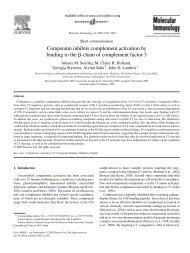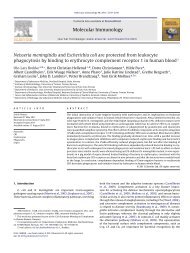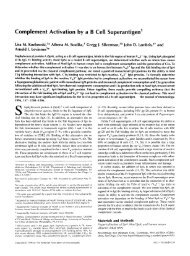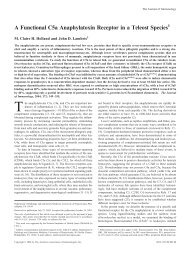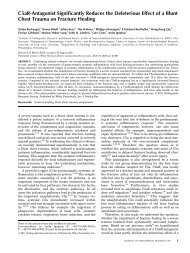IDENTIFICATION OF A C3bi-SPECIFIC ... - John D. Lambris
IDENTIFICATION OF A C3bi-SPECIFIC ... - John D. Lambris
IDENTIFICATION OF A C3bi-SPECIFIC ... - John D. Lambris
Create successful ePaper yourself
Turn your PDF publications into a flip-book with our unique Google optimized e-Paper software.
GORDON D. ROSS AND JOHN D. LAMBRIS 101<br />
other smaller C3 fragments generated by proteolysis of C3b or <strong>C3bi</strong> were examined<br />
for inhibition of <strong>C3bi</strong>-ms rosette formation. Inhibition of neutrophil-E<strong>C3bi</strong> rosettes<br />
and human E-<strong>C3bi</strong>-ms rosettes was observed with the fluid-phase small C3 fragments<br />
pool generated with plasmin or trypsin but not with elastase.<br />
Inhibition of <strong>C3bi</strong>-dependent Neutrophil Rosette Formation by Secreted Neutrophil<br />
Elastase. Because of the known proteolytic sensitivity of <strong>C3bi</strong> (9) and because the<br />
bound product of <strong>C3bi</strong> digestion, C3d, was unreactive with neutrophils and monocytes,<br />
protease inhibitors were added to rosette assays to protect the <strong>C3bi</strong>-complexes<br />
from proteolysis into CR3-unreactive C3d complexes (Table IV). Both STI and PMSF<br />
enhanced neutrophil-E<strong>C3bi</strong> rosette formation from 5% up to 76-89%, whereas benzamidine<br />
and epsilon amino caproic acid caused no rosette enhancement. These same<br />
protease inhibitors had no effect on E<strong>C3bi</strong> rosette formation with blood monocytes or<br />
lymphocytes. Because neutrophils were known to secrete elastase in response to<br />
opsonized bacteria (28) and because human neutrophil elastase was known to cleave<br />
<strong>C3bi</strong> into C3c and C3d (20), an antibody to human neutrophil elastase was examined<br />
for its ability to enhance neutrophil-E<strong>C3bi</strong> rosette formation (Table IV). Anti-elastase<br />
produced the same rosette enhancement as did STI and PMSF. In the absence of<br />
protease inhibitors or anti-elastase, E<strong>C3bi</strong> that had been incubated with neutrophils<br />
for 60 min at 37°C were no longer agglutinated by anti-C3c, whereas agglutination<br />
by anti-C3d and Raji rosette formation were undiminished.<br />
Acquisition of Elastase-secreting Ability with Neutrophil Maturation. Neutrophils from<br />
the blood of a patient with chronic myelogenous leukemia and blood count of 2 × 105<br />
neutrophils per/~1 were fractionated into immature (band-form nucleus) and mature<br />
polymorphonuclear cells and examined for E<strong>C3bi</strong> rosette formation with increasing<br />
concentrations of STI (Table V). In the absence of STI, 49% of band-form neutrophils<br />
formed rosettes with E<strong>C3bi</strong>, whereas high-density polymorphs did not form E<strong>C3bi</strong><br />
TABLE IV<br />
Enhancement of Neutrophil-E<strong>C3bi</strong> Rosette Formation with Protease Inhibitors<br />
and Anti-Elastase<br />
Protease inhibitor<br />
Neutrophil-E<strong>C3bi</strong><br />
rosette formation<br />
%<br />
Buffer control 5<br />
STI<br />
1.0 mg/ml 88<br />
0.5 mg/ml 89<br />
0.25 mg/ml 70<br />
0.10 mg/ml 35<br />
0.05 mg/ml 25<br />
PMSF<br />
2.0 mM 36<br />
[.0 mM 76<br />
0.5 mM 40<br />
Anti-elastase<br />
1/5 87<br />
1/10 87<br />
1/20 79<br />
1/40 38<br />
Downloaded from www.jem.org on November 8, 2004





